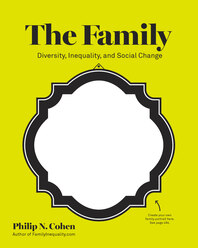
The Family
Diversity, Inequality, and Social Change
24 October 2014
Territory Rights — Worldwide.
Original infographics encourage students to be critical consumers of information Stunning, two-page “Story Behind the Numbers” infographics created expressly for this text explain the statistics students encounter in the media by walking them through the data behind the numbers and helping them better understand social issues encountered by contemporary families. These infographics are also featured on Norton’s YouTube channel, as well as in the ebook and the coursepack.
Integrated workshops help students apply concepts to their own lives. Each chapter features one activity to be completed individually by students, in groups, or in the classroom. Activities are pulled directly from the author’s undergraduate sociology of families course and draw from students’ own experiences, analysis of current events or media, interpretation of a fictional narrative or image, small surveys, or students’ imaginations. Examples of the workshops include challenging students to look at the monthly budget of a single-parent household compared to four different income types, offering an example of a dating script from 1993 and asking students to write a script based on today’s dating norms, and comparing and contrasting wedding videos from varying cultures found on YouTube.
Explores what “the family” means in the 21st century. The book opens with a question: “Is ‘the family’ an outdated institution, out of place in modern society, perpetuating inequality and irrational ideas; or is it a haven in a heartless world?” and every chapter captures the dynamics of contemporary family patterns—the diversity in the timing of family events, the forms that families take, and the nature of intimate relationships—to help students answer the question.
“Changing Context” boxes show how social change has transformed modern families. Every chapter features a “Changing Context” box highlighting the evolving frameworks in which families—and the relations within them—are shaped. These boxes focus on recent developments in politics, culture, law, and technology, with each one showing how the family fits within larger social changes. Box topics include sex education and voter impact on school policies, family violence and the rights of children, gender-neutral approaches to raising children, the campaign to gain wages for housework and the narrowing of the division of labor in the home, parents’ technological monitoring of children, and the dramatic shifts in definitions used by the U.S. Census Bureau to count families.


